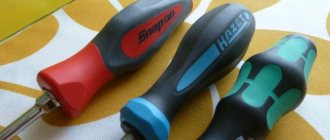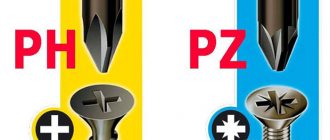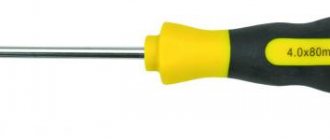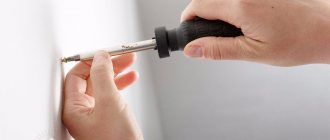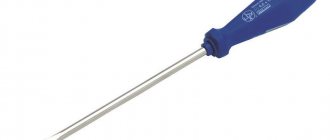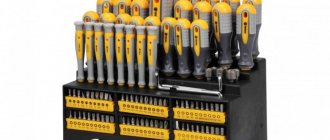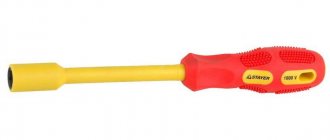Prerequisites for the emergence of a new profile for threaded fasteners
In the early thirties of the 20th century, the straight spline, the first type of spline for threaded fasteners, reached its performance limit.
The industry, especially American automakers, has accumulated a large number of complaints against it:
- screwdrivers were difficult to center on fasteners, and workers spent a lot of time screwing them in, productivity suffered,
- the tip of the screwdrivers often slipped out of the slot and spoiled the surfaces of the parts,
- fasteners with a straight slot could not withstand excess torque; as soon as the bolt or screw was slightly overtightened, the slot broke off, rendering the fastener unusable.
A fundamentally new type of slot was needed. Which could do this:
- self-center the screwdriver blade in the fastener,
- reduce the likelihood of the tip slipping out,
- withstand higher torque,
- have built-in protection against damage to bolts and screws due to accidental overtightening.
A new type of spline that met all these requirements appeared in 1933.
Insulated screwdriver WERA 165 i PZ/S SB VDE for PlusMinus screws (Pozidriv/slotted), 100021
Wera VDE screwdriver with multi-component Kraftform Plus handle for fast and gentle work: hard handle zones for high working speeds, while soft handle zones ensure the transmission of high torques. Combined slot/Pozidriv* profile, primarily for working with connection terminals, fuse boxes, switches, relays. Tools are individually tested to IEC 60900. Individually tested in a 10,000 V water bath for safe operation on equipment with a maximum allowable voltage of 1000 V. The hexagonal edge of the handle prevents annoying rolling of the screwdriver in the workplace.
- Electrically insulated blade according to VDE standards for safe operation under voltages up to 1,000 V
- Hard handle zones for high working speed, soft handle zones for transmitting high torques
- With handle markings for easy selection and sorting of tools
- With hexagonal edge handle for anti-roll protection
- Combination Phillips/Spline Profile
Kraftform Kompakt VDE sets are tested individually according to IEC 60900 under water bath conditions at 10,000 V. A test load of 10,000 V, ten times the maximum permissible voltage of 1,000 V, guarantees safe operation. A must-have tool for use with in-line terminals, fuse blocks, switches, relays, etc. Combined slot/Phillips or slot/Pozidriv profile. Individual testing at 10,000 V according to IEC 60900 guarantees safe operation at voltages up to 1,000 V.
In extreme application conditions, safety is also guaranteed thanks to proven shock resistance at low temperatures of −40 °C.
Wera produces the Kraftform handle from several materials with different properties. For the middle part, resistant plastic is used, which firmly holds the working end even under high loads. For colored areas, a softer material is used. The material has a high degree of friction and ensures the transmission of high forces. Black areas with harder surfaces prevent the handle from sticking to the palm. This allows you to quickly grab the screwdriver in your hand. The Kraftform handle, perfectly adjusted to the shape of the palm, protects the hand from calluses and blisters.
The handle uses hard materials, so you can quickly grab it without any fear that it will “stick” to your palm. The solid area of the handle with the largest diameter rotates in the hand like a wheel. Marking the tip type and size on the handle of the screwdriver makes it easier to find it in your tool bag and on your workbench.
The invention and authorship of the cross slot is an unusual story
A new type of cross-shaped slot was invented in 1933 by the American inventor John P. Thompson. But large manufacturers of hardware did not appreciate the invention.
Only 2 years later, in 1935, engineer Henry F. Phillips became interested in his invention.
Henry Phillips, the man whose name is named after the most common type of fastener in the world. /photo geni.com/
He bought the rights to the cross slot from Thompson. After which I spent about a year polishing the design of the profile and screwdriver.
In 1936, Phillips patented a modified Phillips spline. As a result, the tip of the screwdriver or screwdriver was centered strictly in the center of the fastener. And when tightening, the tool simply popped out of the head of the bolt or screw without damaging the fastener.
Even the numbers and copies of his patents have been preserved: US Patent #2,046,343, US Patent #2,046,837 - 2,046,840.
Henry Phillips patent US2046837-0 for a Phillips slot. /photo Google Patents/
Henry Phillips patent US2046840-0 for a Phillips slot. /photo Google Patents/
Confident of the success of the new Phillips screw, Henry Phillips founded the Phillips Screw Company. The company, by the way, still exists and is the copyright holder for all types of Phillips splines.
The first major customer to introduce Phillips screws and bolts on its assembly lines was General Motors. The automaker has launched a new type of fastener on the Cadillac assembly line.
The success of Phillips fasteners was so resounding that by 1940, virtually all American fastener manufacturers (more than 85%) were lining up with the Phillips Screw Company to purchase a production license.
And the name Henry Phillips became a household name and was forever attached to the cross slot.
By the way, in the Russian nomenclature there is a separate GOST for a Phillips slot - GOST 10753-86.
Two types of cross bits
PH stands for Phillips. It has the shape of a regular cross. Good idea. There are practically no cons. It was first developed by Phillips engineers.
PZ – stands for Pozidrive. It has the shape of a cross with characteristic notches between the edges.
The Ph bit is more versatile. It can be used to tighten both Ph and Pz screws. The only thing is that it dangles in the Pz screw. Because it has less completeness.
With a Pz bat you can only spin Pz; it doesn’t fit into Ph and breaks off the edges.
Bit marking
Each bit is marked. Either a sticker has been pasted, or the value for which screw it is suitable for has been punched out with a press. That is, the same Ph or Pz and its dimensions 1, 2, 3. About the dimensions a little lower.
Bit size
Bit lengths are 25 mm, 50 mm, 70 mm, 90 mm, 120 mm, 160 mm, 200 mm.
But besides length, they also differ in numbers. The Ph bits are marked as Ph 1, Ph 2, Ph 3. The Pz bit is: Pz 1, Pz 2, Pz 3.
As a rule, sizes smaller than Ph 1 and Pz 1 are not used. There are no screws for them.
They can be used somewhere in radio engineering and electronics. There are also no bits larger than Ph 3 and Pz 3. Larger screws have other types of bits, for example, a star or hexagon.
Why does a self-tapping screw need its own bit?
The bit or screwdriver must fit the screw. By the way, recently screwdrivers also indicate which screws it fits.
Read also: Operating principle of a bearing video
Why is it so important to choose the right bat?
Firstly, using the wrong tool, you constantly tear off the cross hole in the screw. This makes it difficult to unscrew the fastener in the future.
Second, you wipe down the edges on the bat itself. Thus quickly rendering it unusable.
I will continue the topic of screwdrivers! ))
Everyone knows a Phillips screwdriver, many know that they come in different sizes, and if you twist a large screw with a small screwdriver, it will break off and the screw will not come out, and if you twist a small screw with a large screwdriver, then the screw itself can be torn off.
But not everyone knows, there are 2 types of Phillips screwdrivers:
— Phillips
(abbreviated
PH
)
— Pozidriv
(abbreviated
PZ
)
Phillips
- a regular Phillips screwdriver, a very old standard, it is gradually being replaced by the newer
Pozidriv
- it has additional notches and modified bevel angles of the tip (tip of the screwdriver) and the slot (the recess in the screw where the tip of the screwdriver is inserted) so that the screwdriver holds in the screw much better than in the old version from Philips.
Many people don’t know the difference, and they wrap whatever they have to and with whatever they have to! )
Of course you can do this, but in screws and screws PH
PZ
screwdriver (like the
PH
in
PZ
screws due to the different bevel angles of the tip and slot) does not fit tightly, there is play, the likelihood of failure increases, the bits (attachments) deteriorate faster - the quality and speed of work drop due to the use of the wrong tool.
You can easily feel how much the PZ
fits more tightly in the
PZ
than in
the PH
(and vice versa).
Therefore, it is, of course, advisable to use the right tool.
Distinguish between screws and PH
from
PZ
it is very easy - in
PZ
there are additional notches in the cross, in
PH
there are none:
Screwdrivers and bits (bits) are even easier to distinguish - in addition to the obvious difference in appearance, they are always marked PZ
or
PH
.
In this example, the screwdrivers and bits are size “1”.
Screwdrivers are always marked with the type and size: in this case PZ1x80mm
This means that this is a screwdriver for a Pozidriv slot of size “1” (1 and 2 are the most popular sizes at home), the length of the working part of the screwdriver is 80 millimeters (there are shortened and elongated screwdrivers).
These particular screwdrivers also have a visual drawing that helps the technician much more easily select the right screwdriver:
Drive screws and PZ
PZ
screwdrivers , and
PH
with
PH
! ))
Phillips (eng. Phillips) is a registered trademark [1] denoting the oldest and most famous type of Phillips recess of threaded fasteners and screwdrivers for them.
Read also: Why are diodes needed in a circuit?
History [edit | edit code]
The straight slot has existed, according to some sources, since the 15th century. However, this slot has disadvantages, which were especially evident during the mass assembly of cars and airplanes:
- The screwdriver or screwdriver slips out of the slot, scratching the parts being connected.
- When working with a mechanical screwdriver, there is a risk of breaking the slot or thread (ratchets that accurately measure torque did not yet exist at the time of the invention of the Phillips screwdriver).
In 1933, American John P. Thompson developed screws that solved both problems: they automatically centered the tip and pushed it out when the screw was tightened. Engineer Henry Phillips bought Thompson's patent and founded the Phillips Screw Company. Henry Phillips developed the technology for producing such screws, but was unable to implement it at home. Only in 1937 did he manage to interest the management of the American Screw Company. Such screws were first used in the production of Cadillacs. During World War II, such screws began to be used in the production of military equipment [2].
Thompson was not the first inventor to try to improve the design of the screw: for example, back in 1909, a screw with a square slot was patented by the Canadian Peter L. Robertson. It became widespread mainly in Canada. According to half a legend, Henry Ford at one time experimented with Robertson screws and found that their use significantly speeded up the assembly of cars, but received a refusal from the inventor to sell him a patent, as a result of which he switched to an alternative proposal from Phillips - because of which, according to this According to legend, the Phillips slot, not Robertson, became widespread. However, on Canadian-built Ford cars in the 1920s and 30s, all interior trim elements were attached with Robertson screws.
Features [ edit | edit code ]
Markings and sizes [edit | edit code]
Screwdrivers are marked with letters PH
with slot number - 000 (1.5 mm), 00 (2 mm), 0 (3 mm), 1 (4.5/4 mm), 2 (6 mm), 3 (8 mm), 4 (10 mm) [ 3].
Varieties [ edit | edit code ]
- ACR RIBBED PHILLIPS [4] .
Cross slot with straight serrations against ejection (ACR technology = anti-cam-out recess); distinctive marking - ACR. Compatible with all Phillips screwdrivers.
- PHILLIPS II [5] - an improved version of Phillips.
Cross-shaped slot with inclined notches against ejection; distinctive marking - ACR2. Designed to meet increasingly fast assembly processes where the screwdriver may be ejected from the screw, resulting in damage to the surface of the part; facilitates tightening in difficult installation positions and reduces pressure on the spline - resulting in reduced worker fatigue.
- PHILLIPS SQUARE-DRIVE [6] - Phillips combination with a square spline.
Read also: Electric boat motor, how long does the battery last?
Cross slot with notches (ACR technology) combined with a square slot; distinctive marking - PSD = PHILLIPS SQUARE-DRIV Allows significantly higher torque. Only three screwdriver sizes cover the most popular size ranges.
Why Phillips is not related to the Dutch company Philips
Fun fact - Phillips fasteners are often confused with the Dutch company Philips.
So here it is. The Phillips cross-shaped fastening profile has nothing to do with Philips, which produces household appliances, lighting solutions and medical equipment. Although their names are similar.
For reference, the Dutch company was founded in 1891 by Gerard Philips together with his father Frederick. It was originally called Philips & Co, located in Eindhoven in the Netherlands and was engaged in the production of electric lamps.
A little trick to remember: the double L in the name is about fasteners ( Phillips ), the single L is about the Netherlands and household appliances ( Philips ).
Modern Phillips Fastener
Today, a huge number of different types of Philips bolts and screws are produced. These include bolts, self-tapping screws, and screws for metal and wood. It’s impossible to list everything.
Modern Phillips screwdrivers and bits are designated by the abbreviation PH (which means Phillips).
Phillips profile petals have a special conical shape - they thicken as they move away from the tip of the sting. This is the same built-in protection of fasteners from overtightening. The conical shape pushes out the tip of a screwdriver or bits if you apply too much force when screwing.
